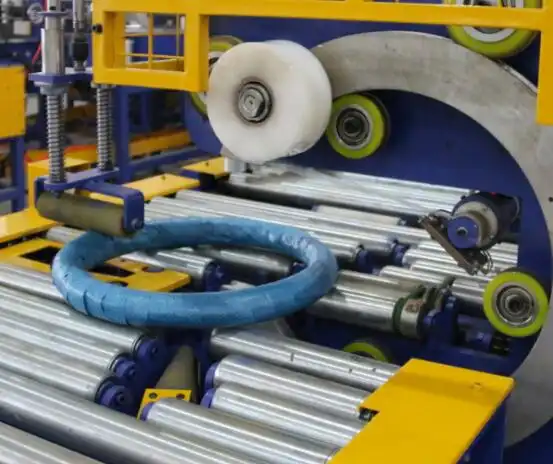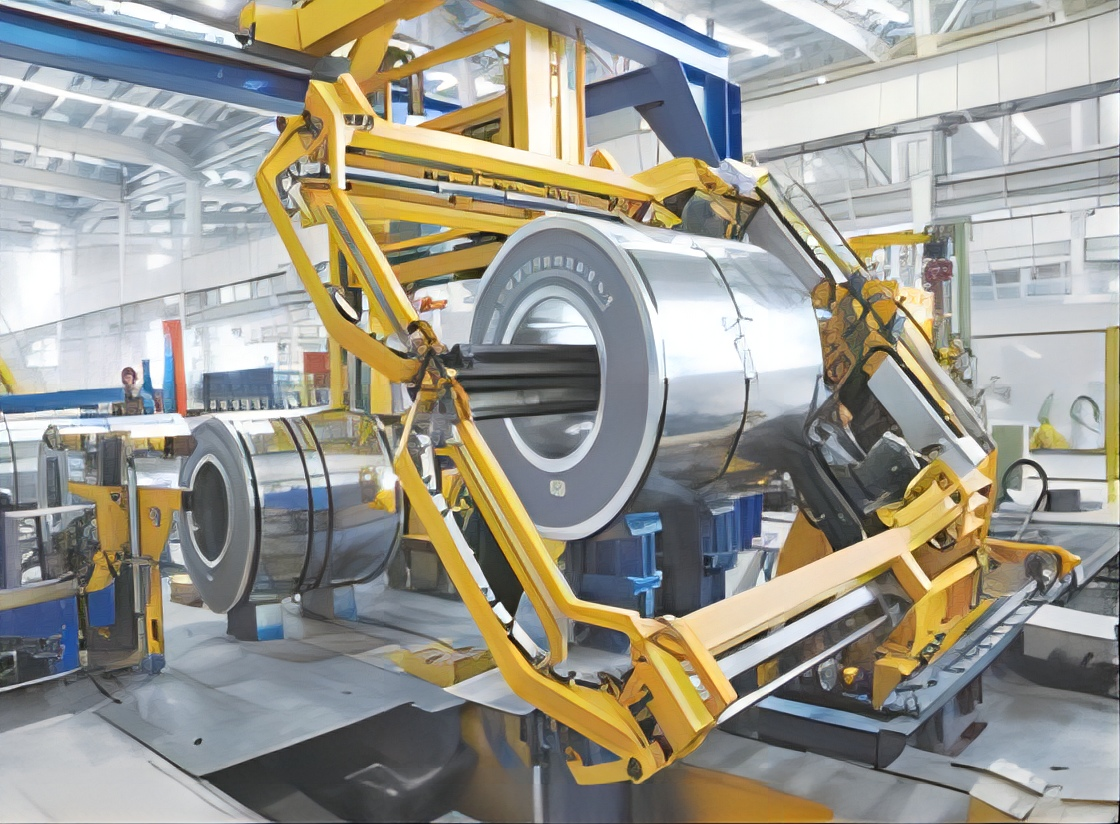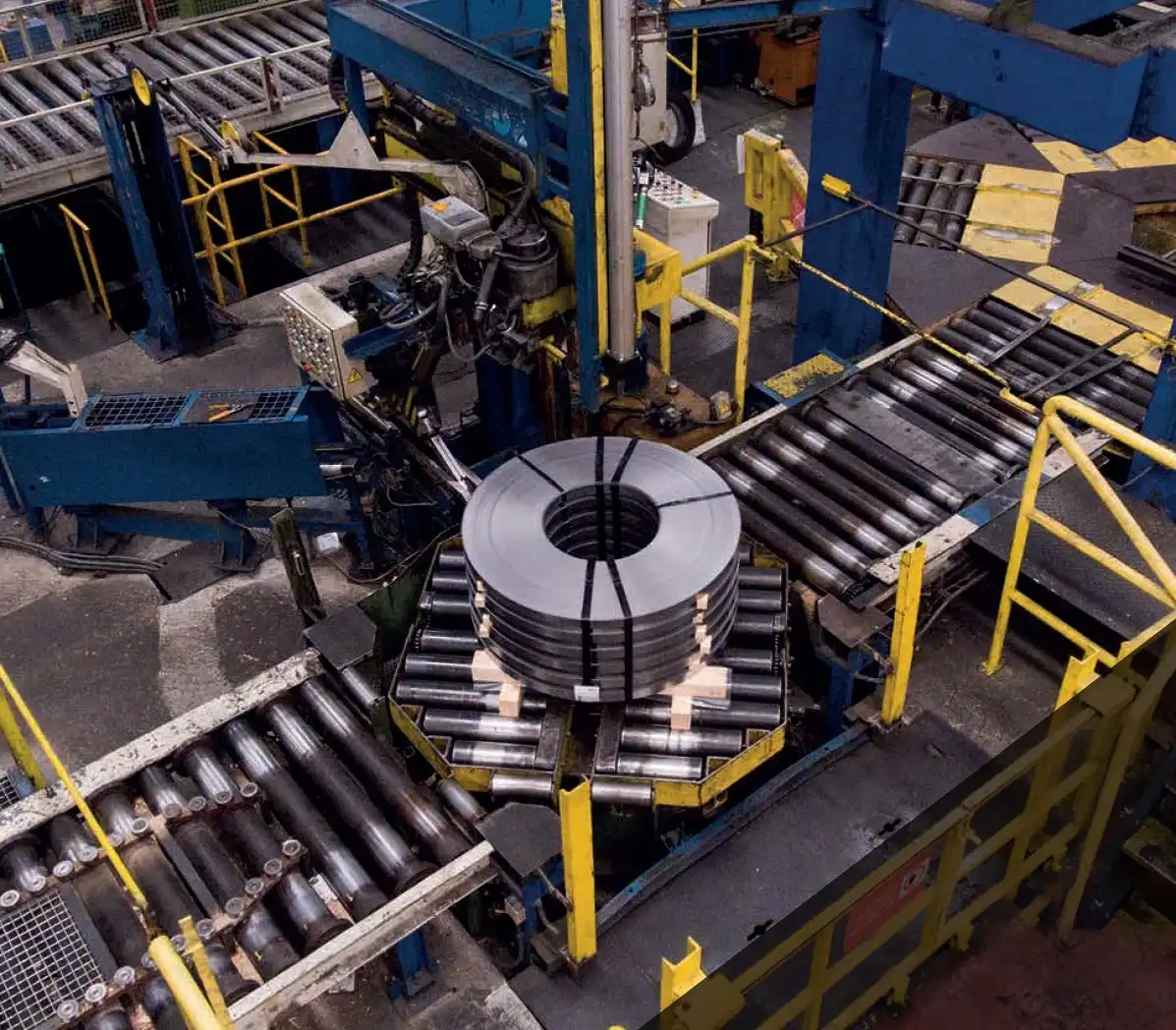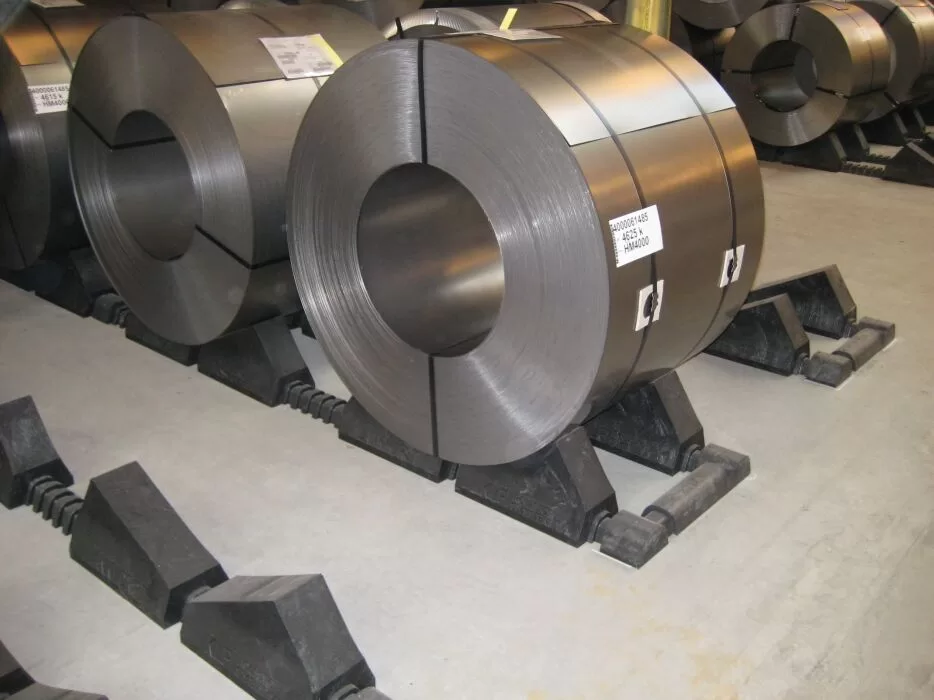Steel coils, the backbone of numerous industries, face a significant threat during storage and transportation: damage. Scratches, corrosion, and deformation can lead to hefty losses and project setbacks. But what if specialized packaging could eliminate these risks, ensuring your steel coils arrive in pristine condition, ready for immediate use?
Specialized packaging solutions are crucial for protecting steel coils, especially considering the distinct properties of cold-rolled and hot-rolled steel. These solutions range from temperature-sensitive wraps to robust anti-scratch and oxide prevention methods, ensuring coils maintain their integrity from production to application.
This article delves into the world of specialized packaging for steel coils, exploring the nuances between cold-rolled and hot-rolled steel and unveiling the ideal packaging strategies to safeguard these essential industrial materials.
Understanding the Distinct Needs: Hot-Rolled vs. Cold-Rolled Steel Coil Packaging
Imagine investing in top-grade steel coils only to find them marred by rust or physical damage upon arrival. The frustration and financial implications are undeniable. The solution? Tailored packaging that acknowledges the fundamental differences between hot-rolled and cold-rolled steel.
Hot-rolled steel coils, known for their formability, benefit from packaging that protects their rougher surface from further oxidation and physical damage during transit. Cold-rolled steel coils, prized for their smooth finish and precision, require specialized packaging that prevents scratches and maintains their pristine surface quality, ensuring they arrive ready for demanding applications.
But how exactly do these packaging solutions differ, and what makes them so critical? Let’s unroll the details.
Hot-Rolled Steel Coil Packaging: Robust Protection for Industrial Strength
Hot-rolled steel, with its characteristic mill scale and higher susceptibility to oxidation, demands packaging that prioritizes robust protection. Simply wrapping it in standard material won’t suffice. We need solutions engineered for its specific vulnerabilities.
Packaging for hot-rolled steel coils focuses on preventing rust and physical damage during transportation and storage. This typically involves moisture barriers and sturdy materials to withstand the rigors of industrial handling, ensuring the coils arrive ready for processing despite their less refined surface.
To truly understand the specialized needs, we must dive deeper into the challenges and solutions.
Key Considerations for Hot-Rolled Steel Coil Packaging
Hot-rolled steel coils, while valued for their strength and cost-effectiveness, present unique packaging challenges due to their inherent properties and typical applications. Let’s break down these considerations:
- Surface Condition: Hot-rolled steel exhibits a mill scale, a layer of iron oxide formed at high temperatures. While sometimes beneficial, this surface is rougher and more porous than cold-rolled steel, making it more susceptible to rust if exposed to moisture. Packaging must act as a robust moisture barrier.
- Dimensional Tolerances: Hot-rolled steel has looser dimensional tolerances compared to cold-rolled. While precise dimensions are less critical for many hot-rolled applications (like structural components), the packaging must still prevent coil unwinding or shifting that could lead to damage and safety hazards during handling.
- End-Use Applications: Hot-rolled steel is often used in heavy industrial applications where some surface imperfections are acceptable. However, even for these applications, excessive rust or physical damage can compromise structural integrity or require costly rework. Packaging should minimize damage to maintain usability.
To address these considerations effectively, specialized packaging for hot-rolled steel often incorporates the following elements:
| Feature | Description | Benefit |
|---|---|---|
| Moisture Barrier | Heavy-duty wrapping films, often multi-layered, including polyethylene or VCI films. | Prevents moisture ingress, crucial for combating rust formation on the mill scale surface. |
| Edge Protection | Cardboard or steel edge protectors, sometimes reinforced with metal strapping. | Protects coil edges from dents, deformation, and unwinding, especially during rough handling and transit. |
| Robust Strapping | Steel or high-strength plastic strapping, applied tightly and securely. | Ensures coil stability and prevents shifting during transportation, maintaining coil integrity. |
| Skid/Pallet Support | Heavy-duty skids or pallets, often steel or reinforced wood. | Provides stable base for handling and stacking, minimizing ground contact and potential for deformation. |
By understanding these specific needs and implementing tailored packaging solutions, businesses can significantly reduce damage to hot-rolled steel coils, ensuring cost-effective and efficient utilization in their intended applications. Choosing the right packaging is not just about wrapping steel; it’s about safeguarding investments and ensuring operational efficiency.
Cold-Rolled Steel Coil Packaging: Preserving Perfection and Precision
Cold-rolled steel coils are the epitome of surface finish and dimensional accuracy. They are destined for applications where aesthetics and tight tolerances are paramount. Therefore, their packaging must be equally refined, acting as a shield against even the slightest imperfection.
Packaging for cold-rolled steel coils is meticulously designed to prevent scratches, dents, and any surface damage that could compromise their superior finish. This often includes interleaving materials, specialized films, and careful handling procedures to maintain the coil’s pristine condition, essential for high-precision applications.
But what are the specific packaging techniques employed to achieve this level of protection? Let’s explore further.
Advanced Techniques for Cold-Rolled Steel Coil Packaging
Protecting cold-rolled steel goes beyond basic wrapping. It demands a comprehensive approach, employing advanced techniques to safeguard its delicate surface and precise form. Let’s examine some of these crucial methods:
- Interleaving: This involves placing a protective layer between each wrap of the coil. Materials like paper, non-woven fabrics, or specialized films are used to prevent coil-on-coil abrasion, a major cause of scratches and surface defects.
- Temperature-Sensitive Wrapping: For coils destined for environments with temperature fluctuations, temperature-sensitive wrapping films are employed. These films adapt to temperature changes, preventing condensation buildup within the packaging, which can lead to rust, even on cold-rolled steel.

temperature-sensitive wrapping - Vacuum Packaging: In extremely sensitive applications or for long-term storage, vacuum packaging can be utilized. This process removes air from within the packaging, further minimizing oxidation and preventing movement that could cause surface damage.
- Suspension Packaging: For exceptionally delicate coils, suspension packaging can be employed. This method suspends the coil within the packaging, preventing any direct contact with the outer surfaces and eliminating the risk of abrasion or pressure marks.
These advanced techniques, while potentially adding to packaging costs, are invaluable for preserving the integrity and value of cold-rolled steel coils. They ensure that the superior qualities of cold-rolled steel are maintained, delivering maximum performance in demanding applications.
- Delving into Specific Packaging Materials and Their Properties
To further enhance our understanding, let’s explore the materials commonly used in specialized steel coil packaging and their respective advantages:
- VCI (Vapor Corrosion Inhibitor) Films: These films release corrosion-inhibiting vapors that create a protective atmosphere around the steel coil, preventing rust even in humid conditions. VCI films are particularly beneficial for long-term storage and ocean transport.
- Non-Woven Fabrics: Soft, non-abrasive, and breathable, non-woven fabrics are excellent interleaving materials, preventing scratches while allowing for some ventilation, reducing condensation risk.
- Stretch Wrap Films: Offering conformability and load containment, stretch wrap films are used for outer wrapping, securing the coil and providing a basic moisture barrier. Specialized stretch films with UV protection or enhanced tear resistance are also available.
- Steel Strapping: High-tensile strength steel strapping provides robust security for heavy coils, ensuring they remain tightly bound during transit. However, it’s crucial to use edge protectors with steel strapping to prevent damage to coil edges.
- Plastic Strapping (PET/PP): A lighter and safer alternative to steel strapping, high-strength plastic strapping offers excellent load retention and is less likely to damage coil surfaces.
Choosing the right combination of these materials, tailored to the specific properties of the steel coil and the anticipated shipping and storage conditions, is paramount for effective specialized packaging.
Anti-Scratch Solutions: Maintaining Surface Integrity
Scratches on steel coils, especially cold-rolled, are more than just cosmetic blemishes. They can compromise surface integrity, affect coating adhesion, and even impact the functionality of the final product. Therefore, anti-scratch solutions are a cornerstone of specialized steel coil packaging.
Effective anti-scratch packaging for steel coils utilizes a combination of protective interleaving, cushioning materials, and careful handling practices. These solutions minimize surface abrasion during transit and handling, preserving the coil’s finish and quality, crucial for applications requiring flawless surfaces.
But what are the practical implementations of these anti-scratch strategies? Let’s investigate.
Implementing Robust Anti-Scratch Measures
Combating scratches requires a multi-faceted approach, focusing on material selection, packaging design, and handling protocols. Here are key strategies for implementing robust anti-scratch measures:
- Interlayer Protection is Paramount: As discussed earlier, interleaving materials are the first line of defense against scratches. The choice of material is critical. Soft paper, non-woven fabrics, or specialized films with smooth surfaces are preferred. The thickness and cushioning properties of the interleaving material should be matched to the coil’s weight and surface sensitivity.

Specialized Packaging Solutions - Cushioning and Dunnage: Beyond interleaving, cushioning materials like foam pads or corrugated cardboard inserts can be strategically placed within the packaging to absorb shocks and vibrations during transit. Dunnage, used to fill voids and prevent coil movement, should also be non-abrasive and compatible with steel surfaces.
- Specialized Wrapping Techniques: The wrapping process itself plays a crucial role. Tight, even wrapping minimizes coil movement and reduces the potential for surface abrasion. Techniques like spiral wrapping or pre-tensioned wrapping films can enhance stability and protection.
- Gentle Handling Procedures: Even the best packaging can be undermined by rough handling. Training personnel in proper lifting, loading, and unloading techniques is essential. Using specialized handling equipment, such as coil grabs with non-marring pads, further minimizes the risk of scratches and dents.
By implementing these comprehensive anti-scratch measures, manufacturers and distributors can significantly reduce surface defects, ensuring that steel coils, particularly cold-rolled varieties, arrive in pristine condition, ready for their intended applications without costly rework or rejection.
Oxide Prevention Strategies: Combating Corrosion
Oxidation, or rust, is the nemesis of steel. It degrades surface quality, weakens structural integrity, and renders steel coils unusable. Effective oxide prevention strategies are, therefore, non-negotiable in specialized steel coil packaging.
Preventing oxide formation in steel coil packaging relies on creating a barrier against moisture and oxygen, the primary catalysts for rust. This is achieved through moisture-proof wrapping materials, desiccants, and controlled atmosphere packaging techniques, ensuring coils remain corrosion-free during storage and transit.
How can these oxide prevention strategies be effectively applied in practice? Let’s explore the details.
- Deep Dive into Oxide Prevention Methods
To effectively combat oxidation, a combination of preventative measures is typically employed, tailored to the specific storage and transportation conditions. Key oxide prevention methods include:
| Method | Description | Advantages | Limitations |
|---|---|---|---|
| Barrier Films | Multi-layered films with excellent moisture and oxygen barrier properties, such as polyethylene laminates. | Cost-effective, provides a basic level of protection against moisture and oxygen ingress. | May not be sufficient for long-term storage in highly humid environments. |
| VCI Packaging | VCI films, papers, or emitters release corrosion-inhibiting vapors, creating a protective atmosphere. | Provides active corrosion protection, effective even in the presence of minor moisture ingress, suitable for long-term storage. | Can be more expensive than barrier films, VCI effectiveness can be affected by packaging integrity. |
| Desiccants | Moisture-absorbing materials like silica gel or clay, placed within the packaging. | Absorbs moisture within the package, reducing humidity levels and preventing condensation. | Desiccant capacity is limited, needs to be calculated based on package size and expected humidity exposure. |
| Controlled Atmosphere Packaging | Replacing air within the package with inert gases like nitrogen or argon. | Eliminates oxygen, a key component in oxidation, provides superior long-term corrosion protection. | More complex and expensive to implement, requires specialized equipment and gas purging procedures. |
| Protective Coatings | Applying rust-inhibiting oils or coatings to the steel coil surface before packaging. | Adds an extra layer of corrosion protection, especially beneficial for long-term storage or harsh environments. | Adds a processing step, coatings may need to be removed before further processing of the steel. |
Choosing the most appropriate oxide prevention strategy depends on factors like storage duration, environmental conditions, budget constraints, and the sensitivity of the steel grade to corrosion. Often, a combination of these methods provides the most comprehensive and reliable protection.

Zeeco Metals: Your Partner in Specialized Steel Coil Solutions

Beyond precision slitting, Zeeco Metals understands the critical role of specialized packaging in delivering steel coils in optimal condition. We offer tailored packaging solutions designed to complement our meticulous processing services.
Zeeco Metals provides comprehensive steel coil solutions, including specialized packaging tailored to hot-rolled and cold-rolled steel. Our packaging options incorporate temperature-sensitive wrapping, anti-scratch interleaving, and oxide prevention methods, ensuring your steel coils are protected from damage and corrosion during transit and storage.
From temperature-sensitive wrapping to robust oxide prevention, Zeeco Metals is committed to providing end-to-end solutions that safeguard your steel coil investments. We recognize that superior steel demands superior protection, and our specialized packaging services are designed to deliver exactly that – peace of mind and pristine steel, every time.
Conclusion
In conclusion, specialized packaging solutions are not merely an afterthought but an integral component in ensuring the quality and usability of both cold-rolled and hot-rolled steel coils. By understanding the distinct properties of each steel type and implementing tailored packaging strategies – from temperature-sensitive wrapping to robust anti-scratch and oxide prevention methods – businesses can significantly minimize damage, reduce waste, and maximize the value of their steel coil investments. For businesses seeking reliable and comprehensive coil packing line solutions, partnering with experts who understand the nuances of steel and packaging is paramount.








